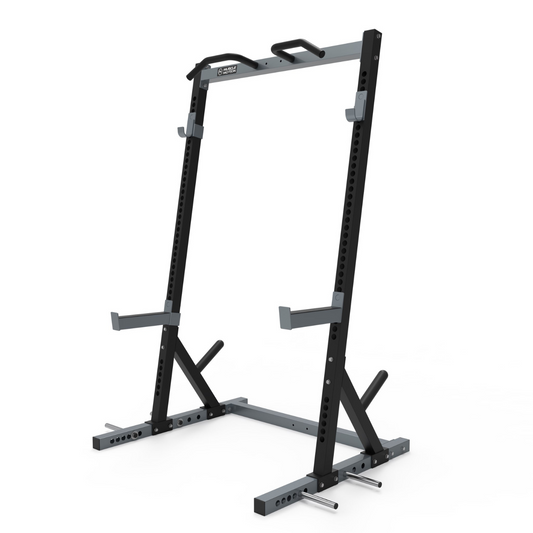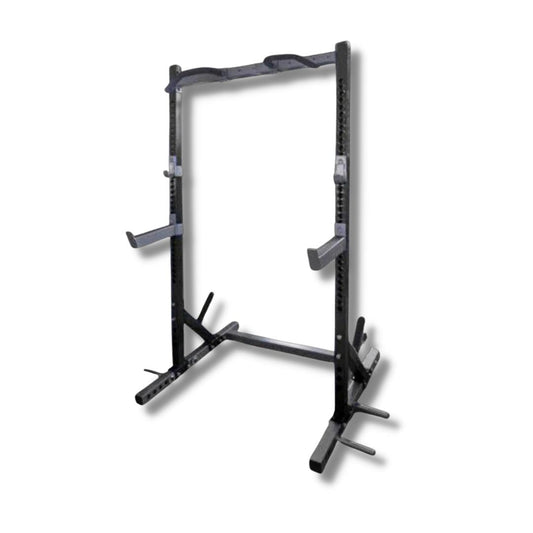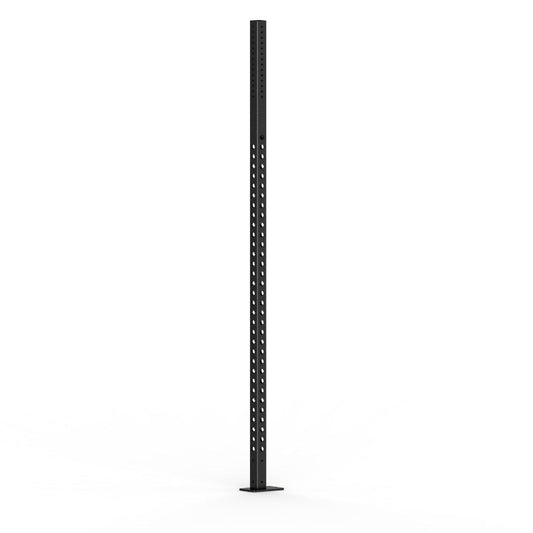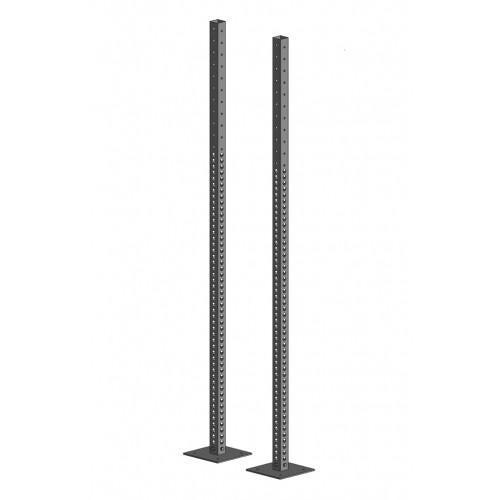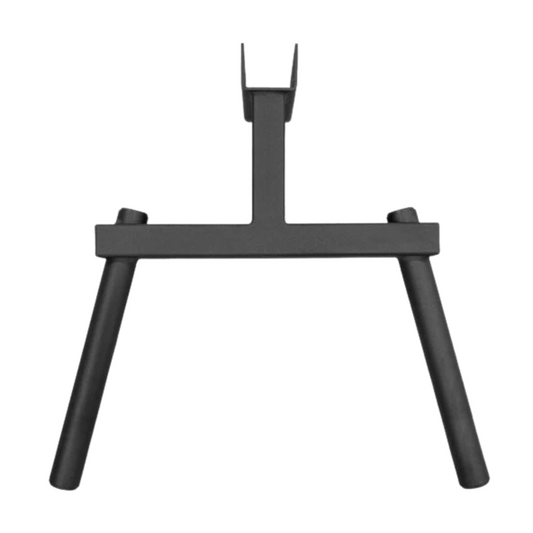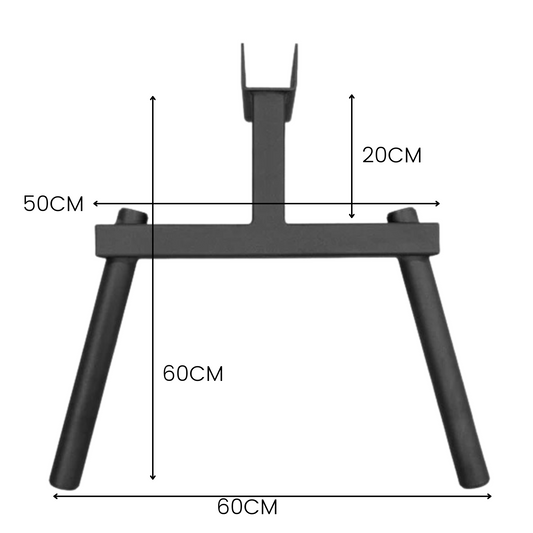What are the benefits of using gym machines, rigs or racks in my workout routine?
There are several types of gym machines and racks available, each with their own unique features and benefits. Here are some of the most common types of gym machines and racks and how they can benefit your fitness goals:
-
Power racks: Power racks, also known as squat racks or power cages, are ideal for strength training exercises such as squats, bench presses, and shoulder presses. They typically feature adjustable safety bars, pull-up bars, and weight plate storage, making them a versatile option for a full-body workout.
-
Smith machines: Smith machines are similar to power racks, but they feature a guided barbell that moves along a fixed vertical track. They are ideal for exercises such as bench presses, squats, and lunges, and can be a good option for those who are new to weightlifting or need additional support and stability.
-
Cable machines: Cable machines use pulleys and cables to create resistance and can be used for a wide range of exercises, including chest flyes, rows, and triceps pushdowns. They are versatile, customizable, and can be used to target specific muscle groups.
-
Leg press machines: Leg press machines are designed to target the muscles in your legs, including your quadriceps, hamstrings, and glutes. They can be a good option for those who may have difficulty performing squats or lunges with free weights.
-
Rowing machines: Rowing machines are ideal for cardio and full-body workouts, as they engage your legs, core, and upper body. They can help to improve cardiovascular endurance, build muscle, and burn calories.
-
Ellipticals: Ellipticals are low-impact cardio machines that can help to improve cardiovascular endurance, burn calories, and tone your lower body. They can be a good option for those who may have joint pain or mobility issues.
When choosing gym machines and racks, it's important to consider your fitness goals, experience level, and any physical limitations or injuries you may have. Consulting with a fitness professional or personal trainer can help you choose the best gym machines and racks for your individual needs and goals.
What are some of the best exercises to do with gym machines or racks, and how to target specific muscle groups?
Gym machines and racks can be used for a variety of exercises that target specific muscle groups and help you achieve your fitness goals. Here are some of the best exercises you can do:
-
Leg press: This exercise targets your quadriceps, hamstrings, and glutes. Sit in the leg press machine with your feet on the footplate and push the plate away from your body, then slowly return it to the starting position.
-
Lat pulldown: This exercise targets your back muscles, including your lats. Sit in the lat pulldown machine with your hands gripping the bar overhead, then pull the bar down towards your chest and slowly release it back to the starting position.
-
Chest press: This exercise targets your chest muscles, including your pectorals. Sit in the chest press machine with your hands on the handles, then push the handles away from your body and slowly return them to the starting position.
-
Seated row: This exercise targets your upper back muscles, including your rhomboids and trapezius. Sit in the seated row machine with your hands gripping the handles, then pull the handles towards your chest and slowly release them back to the starting position.
-
Squat rack: This exercise targets your quadriceps, hamstrings, and glutes. Stand in the squat rack with the barbell resting on your shoulders, then squat down until your thighs are parallel to the floor and stand back up.
-
Deadlift: This exercise targets your lower back, glutes, and hamstrings. Stand in front of the barbell in the deadlift rack, then squat down and grab the bar with an overhand grip. Lift the bar up while keeping your back straight, then slowly lower it back down.
Remember to adjust the weight and number of sets and reps based on your fitness level and goals. Consult a fitness professional if you are unsure how to perform these exercises or need guidance on proper form.
What is the cost of a gym machine, and how to budget for it?
The cost of gym machines and racks can vary greatly depending on the type and quality of equipment. For example, a basic power rack may cost a few hundred dollars, while a high-end multi-station gym could cost several thousand dollars.
When budgeting for gym equipment, it's important to consider your fitness goals, the space you have available, and your budget. You may want to start with a few essential pieces of equipment and gradually add more over time as your budget allows.
There are also options for purchasing used or refurbished gym equipment, which can be a more cost-effective solution. However, it's important to ensure that the equipment is in good condition and safe to use before making a purchase.
Additionally, some gym equipment retailers offer financing options, which can help make larger purchases more manageable over time.
How to incorporate various gym machines, racks & rigs into my workout routine for maximum effectiveness and results, and how often should I use them?
To incorporate gym machines and racks into your workout routine for maximum effectiveness and results, it's important to have a plan and use the equipment in a way that targets specific muscle groups and allows for progressive overload over time.
Here are some tips on how to incorporate gym machines and racks into your workout routine:
-
Plan your workouts: Develop a workout plan that incorporates different gym machines and racks to target different muscle groups. You may want to work with a personal trainer or use online resources to develop a plan that meets your specific fitness goals.
-
Start with the basics: If you're new to using gym machines and racks, start with the basics and gradually progress to more advanced exercises. For example, you might begin with squats and bench presses using a power rack before moving on to more complex exercises.
-
Use proper form: It's important to use proper form when using gym machines and racks to prevent injury and get the most out of your workout. If you're not sure how to use a specific machine or rack, ask a trainer or watch online tutorials to ensure proper form.
-
Incorporate progressive overload: To see results from strength training with gym machines and racks, it's important to gradually increase the weight or resistance over time. This can help prevent plateauing and ensure continued progress.
As for how often to use gym machines and racks, it depends on your fitness goals and workout plan. Generally, it's recommended to strength train 2-3 times per week, with at least one day of rest in between sessions to allow for muscle recovery. However, always consult with a trainer or medical professional before starting any new workout routine.
What is the ideal number of sets and repetitions when using gym machines, and how to create a workout plan?
When it comes to the ideal number of sets and repetitions when using gym machines, it can vary depending on your fitness goals and experience level.
For beginners, it's recommended to start with 1-2 sets of 12-15 repetitions per exercise, using a weight that allows for proper form and technique. As you progress, you can gradually increase the weight and the number of sets and repetitions.
For strength training, 3-4 sets of 6-8 repetitions with heavier weights is more effective. For muscle endurance and toning, 2-3 sets of 12-15 repetitions with lighter weights is recommended.
It's important to vary your workout routine and incorporate different exercises that target different muscle groups. A good way to create a workout plan is to divide your workouts by muscle groups and focus on one or two muscle groups per day. For example, you could do a leg day, chest and back day, and shoulder and arm day.
When using gym machines, it's also important to use proper form and technique to prevent injury and maximize effectiveness. Consider working with a personal trainer to learn proper form and create a personalized workout plan that fits your fitness goals and experience level.


